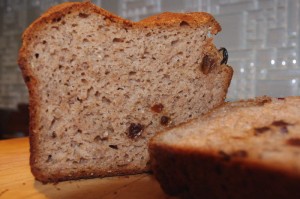Well I’ve had a couple of things I needed to do on the gluten-free baking front, one being to work on a new loaf to add to the mix, and a cinnamon raisin loaf seemed like just the thing.
One of the other things on the list was to incorporate chia seeds into more of the baking as a replacement for eggs.
So having some time this afternoon, off I went with the mixer and baking pans!
I started with a recipe from Betty Hagman (this woman was a gluten-free baking genius!!!) and made a few changes along the way to make it vegan, so this loaf is gluten-free, dairy-free and egg-free!
Oh, one of the other things I’ve been wrestling with is the apparent difference in strength of xantham gums — some are ground more finely than others, and I recently made a change in brands and had some puzzling results which I thought were the fault of yeast (or my fault due to overproofing!) Turned out it was neither, but the fact that the more dust-like xantham gum isn’t as strong as the stuff that has a slightly more granular texture! Of course, I found reference to this in one of the last books Betty Hagman wrote! Oh well, live and learn!!
So here’s the loaf — I modified the recipe to use both xantham gum and guar gum (which results in both working together very nicely). The addition of the chia seeds creates a nice moist loaf with some good shelf-life to it, and the teff creates a nice mildly nutty flavour. The loaf is only very lightly sweet — 1/4 cup of raisins in this one, as I wanted to see how well the dough carried the raisins, it could probably be upped to about 6 Tablespoons for extra raisiny goodness!
Gluten-free Cinnamon Raisin Bread (adapted from a Betty Hagman recipe)
- 80 grams teff flour
- 30 grams sorghum flour
- 154 grams Bette’s Featherlight Mix (equal parts cornstarch, brown rice flour, tapioca starch, plus 1 teaspoon potato flour for every 1 cup other flours)
- 2 tablespoons almond flour
- 3/4 teaspoon xantham gum
- 3/4 teaspoon guar gum
- 1/2 teaspoon salt
- 1 1/2 teaspoons cinnamon
- 1 teaspoon gelatin or agar powder
- 2 Tablespoons evaporated cane juice
- 2 1/2 teaspoons instant yeast
- 2 Tablespoons chia seed soaked in 6T warm water
- 3 tablespoons grapeseed oil
- 2 tablespoons light agave syrup
- 1/2 teaspoon cider vinegar
- 1 cup plus 2 Tablespoons warm wter
- 1/4 cup – 6 Tablespoons raisins
Bake at 400 degrees for 55-65 minutes, until internal temperature registers 205 degrees.
This yeasty recipe is being sent over to Yeastspotting – if you haven’t been there already, go check it out! And if you have already, go on back and see what’ new this week!

[...] Gluten-free Cinnamon Raisin Bread [...]
You got a pretty decent crumb on that bread even though the ingredients have no gluten. Do you find that the texture is bready? (I haven’t baked any gluten free breads yet, but I am curious about them)
Thanks Mimi, the texture on this bread is pretty “bready” but it requires several adjustments/additions to go from what is normally a somewhat crumbly texture to one that resembles the texture of wheat bread. In addition to xantham gum and/or guar gum, I usually add agar or gelatin to my bread doughs. It does a few things, including add to the stretch factor, but also adds moisture and helps mimic the gelatinization of gluten at its set point. I also usually use higher protein flours in yeast-breads — it really helps with the structure of the bread. Best results from using combinations of flours.
This bread looks great! I just love cinnamon raisin bread!
Yummy! I would love to try this using Kamut Khorasan Wheat! I just love the taste so much and it is especially great for some who have gluten intolerance! Thanks for sharing this!
I haven’t tried that particular brand of Kamut, but have found that only the occasional person with wheat sensitivities is able to eat Spelt or the Kamut that I have access to — never folks with gluten intolerence, and definitely not those with celiac. If you do make the recipe with Kamut flour, you will need to adjust as this recipe has both xantham gum and guar gum to compensate for the absence of gluten. You probably also wont need the agar or gelatin powder.
Yummy, I am sold!
W
ill try to make this bread for my friend Alice who’s recently diagnosed as wheat-allergic –but not celiac– she ate gluten-filled bread all of her life until several months ago.
Do you think there is a difference between gelatin and agar powder that would affect the bread outcome? Could I use flax seeds instead? And replace all liquid sweetener with maple syrup without affecting the texture/structure?
Wish me luck for I’ve never done any GF bread. Will report back.
Thanks so much for sharing the recipe.
Many of my friends are gluten intolerant and some of them even are gluten-free and lactose intolerant! I’m going to pass this recipe along.
I work with the USA Rice Federation so rice and its role in the gluten-free diet is always on my mind! We just identified gluten-free and gluten-free modification recipes on our website and I’m hoping some of them would be of interest to you: http://riceinfo.com/recipes/gluten-free/.
All recipes were reviewed by Shelley Case (author, Gluten-Free Diet).
Please let me know if you try any of them. Enjoy AK
AK